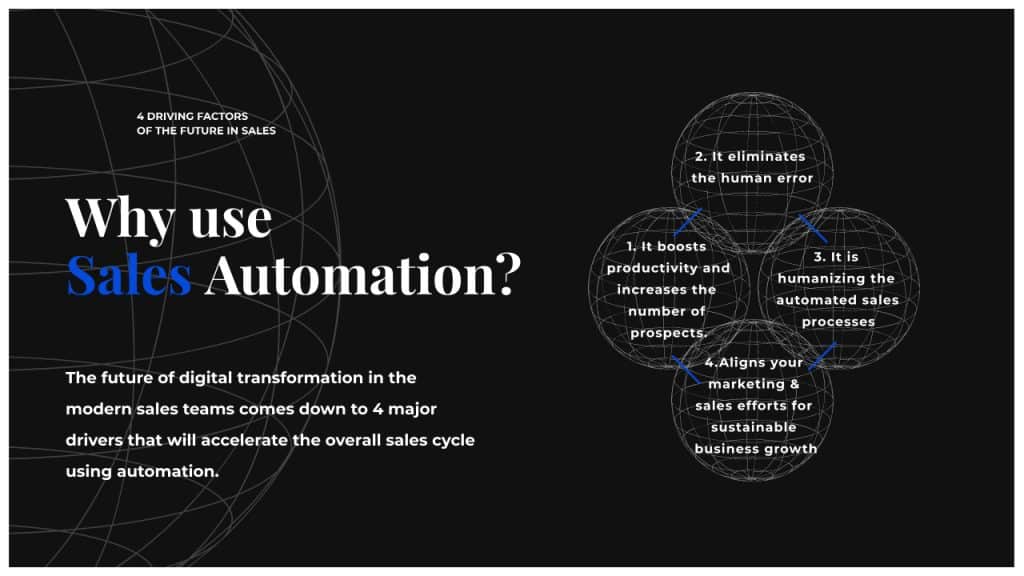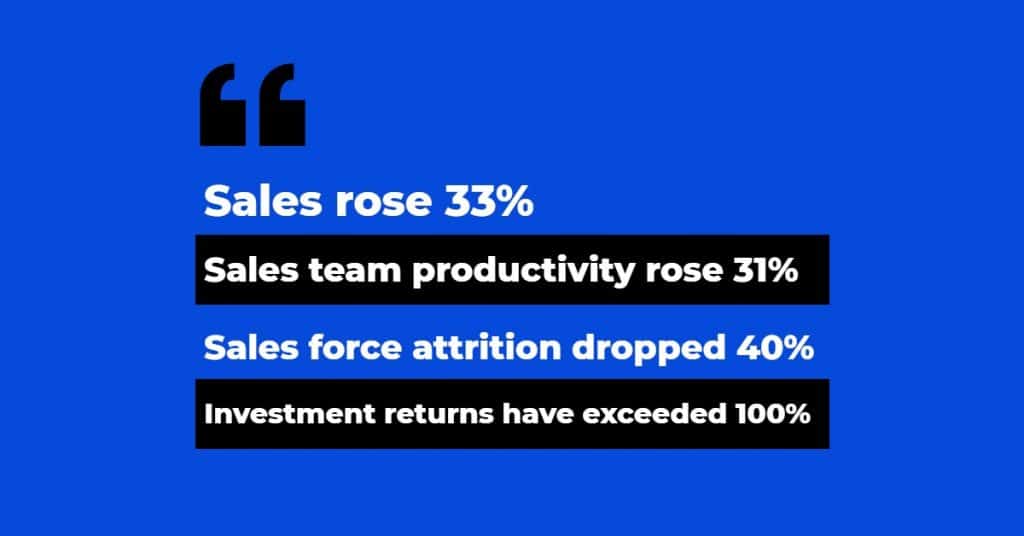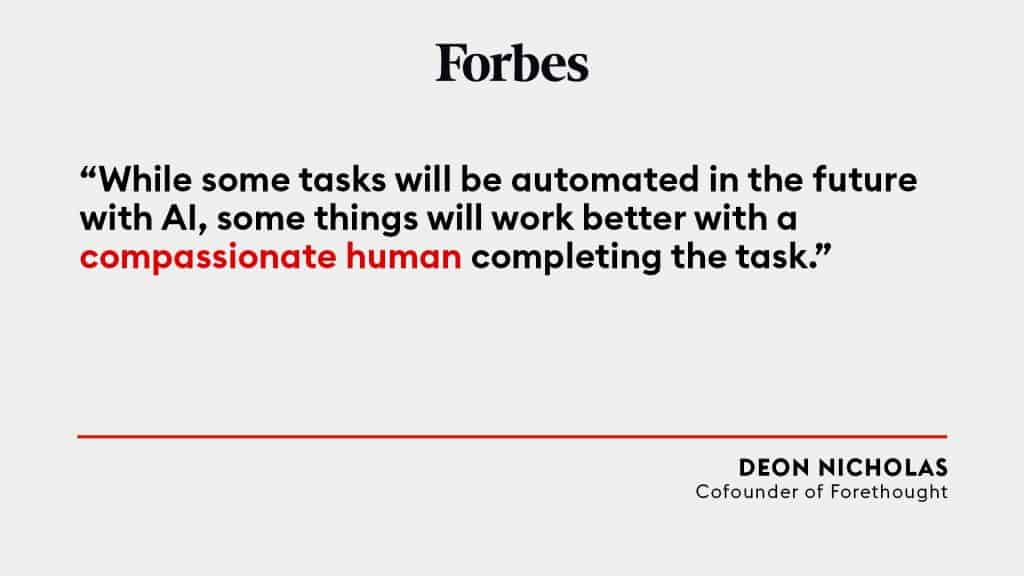Updated on March 14, 2022
The New Definition of Sales Automation
In the past few years, we all witnessed rapid advancement in technology and software solutions as more and more businesses went fully digital. In 2020 even more so, due to the new virus restrictions. And while we may be back on the streets and offices, the digital transformation we already went through is here to stay.
This shift towards digitalization touched every profession in one way or another, including sales. Luckily, the growing and overwhelming demands of the sales job are followed by growth in technical and smart software solutions for sales automation. The last year pushed us into some unplanned, sudden changes in how we buy, how we work, how we live our lives, and also, how we sell.
So let’s take a look at where do technology and sales meet in this new business environment?
Sales automation is the practice of using software-based solutions to automate the repetitive, manual tasks of modern sales teams leaving their hands free to get the most of their day and grow relationships with their prospects.
But in today’s post-pandemic and economically drained sales landscape, the new definition of Sales Automation would be humanizing the automated sales processes by embracing hyper-personalization.
The sales automation software helps minimize the time-consuming and mundane processes that every salesperson goes through. This allows them to spend more time on what truly matters – selling. When we add authenticity and personalization in the automated mix what we get is a truly powerful weapon to have in hand through the whole sales cycle.
The blend of automation and personal touch will empower you to achieve outstanding results. Your customers expect to receive personalization – it is the new norm in doing business. Therefore, you got to be relevant to cut through the clutter.
How to get there?
Since those energy-draining sales tasks cannot be fully escaped, on the brighter side – many of them don’t necessarily require the human touch.
Are you wasting precious time by:
- Searching for the contact information of your potential customers manually? And usually not finding it?
- Trying to cold-call the wrong numbers because you haven’t verified them?
- Adding leads to your CRM manually and then segmenting them one by one?
- Sending emails to non-existent or long-forgotten email addresses?
- Warming-up your email domain all by yourself to prevent being marked as spam?
Well, you don’t have to.
Should you invest in a Sales Automation Software?
In 2022, Sales Automation can be perceived as “the holy grail” for the modern sales teams, especially in the B2B environment. And as automation is evolving at the speed of light, businesses have to keep up in order to unlock new opportunities and get to those higher levels of revenue and success.
Why use Sales Automation?

The importance of sales services is also growing, so investment in sales automation systems holds enormous potential for productivity improvements within your organization.
The first most important thing is having a centralized platform where all your data is put together in one place. From there, you can have that data categorized and segmented into many different ways according to who you aim to target and what you aim to achieve.
Then, you can do many things with automation to:
- Boost sales teams’ productivity and efficiency;
- Increase your numbers for prospects and sales;
- Eliminate human errors;
- Enable email automation for the overall email strategy;
- Personalize every point of contact during the sales cycle;
- Align your marketing and sales efforts for sustainable growth of your business.
Sales Automation Boosts Productivity
Sales automation is closely related to marketing & sales productivity (MSP) systems. This is because it automates huge parts of all sales processes.
Lead Generation and Sales Prospecting for example.
Of course, before your start prospecting, you will need the data about your prospects. Data means many different things for different businesses, and every business is collecting data differently. All of this data is relevant to the salesperson in order to sell. When they get all that information in their hands, they become better at what they do.
The most relevant and recurring data points in the B2B world needed for successful prospecting are the company and contact details of your ideal customer profile.
Such as the current active companies in your target location (region) and industry.
Sales Automation tools enable you to find and target your relevant industries, filtering by industry codes like NACE, SIC, and NAICS codes. You can filter additionally to get information about the company size – number of employees and the web technologies (or technographics) used by those companies. This helps you make a decision whether they are the perfect fit for your business and the solutions you are selling.
For example, if your SaaS integrates with the systems they are already using, it is a green light! If not, good job again! You just saved a lot of time and energy not shooting in the dark, trying to sell something where it is not needed. Eliminate them from your list.
Next, I believe you will need to know the names and job titles of the people working in those companies. Sales.Rocks platform offers the option to see the hierarchy of the company using the “Organizational View” tab.
When your SDRs know who the CEO / Chief Revenue Sales / Account Executive is – or pretty much who is who and on which position in the targeted company – they will know who to contact and how to address them. Whether your sales strategy includes cold calling, cold emailing, or both, everything is much easier when you have the right phone numbers and active emails.
The first most difficult part for all businesses is getting these data streams in. What Sales Automation platforms do to serve their customers is removing the complexity behind searching for the needed data & collecting it manually.
When you are a startup company or a small business, no matter what kind of product or service you provide, in the beginning, you have a team pulling and parsing the data manually. Then trying to make sense out of it. A sales automation platform will remove all that work for you automatically, saving your team a ton of time and energy.
It reduces almost 90% of the time the sales reps spend on generating leads by giving them access to the relevant data. In turn, this dramatically increases the productivity of the sales teams + the number of prospects.
According to Harvard Business Review, sales increases arising from sales automation technology have ranged from 10% to more than 30%, and investment returns have often exceeded 100%.
More specifically, sales rose 33%, sales force productivity rose 31%, and sales force attrition dropped 40%. These returns may sound like every sales professionals’ dream, but they are real. Increasing sales productivity has a great impact on the bottom line.

Web development is also a great way for sales automation, a recent study found that web design has significant benefits when it comes to marketing, customer retention, and conversion rates.
Sales Automation eliminates the human error
Rather than relying on human-generated spreadsheets that can be filled with mistakes, you can use automatically created datasheets instead.
Sales Automation Platforms can seamlessly integrate with your email service provider (such as Gmail). And also with the software, you are already using (Zoho CRM, TeamLeader, Zapier…). Once integrated together, you can safely transfer data and information between your favorite sales and marketing tools and have an overview of the accuracy of your sales cycle.
This also provides greater visibility into sales rep and team performance.
When the generated and segmented company and contact lists are visible to the entire team, making human errors in contacting the same prospect is eliminated. Plus, the account executives can see the ongoing email campaigns of each member on their team and manage them accordingly.
Having a phone verifier and an email verifier as part of your sales automation platform additionally helps to eliminate the possibility of making an error such as cold calling the wrong number or sending your emails to non-existent email addresses.
Sales Automation is humanizing the automated sales processes using hyper-personalization
as we mentioned before, personalization is the new norm in doing business.
Designing an email campaign to meet every recipient’s individual requirements, on an advanced personalized level is not an easy job. Especially when you are targeting 50 or 100 prospects at once. In 2021 even more so, when the expectancy level of personal approach has greatly increased.
The ideal sales automation platform will enable you with many options to humanize your sales approach in your email campaigns. Starting from email outbound prospecting to lead nurturing and customer retention.
Platforms that include tools for hyper-personalization, like Sales.Rocks, can provide you with many options for implementing dynamic content straight into your drip campaigns.
If you want to dive deeper into this subject, read this article on the power of hyper-personalization in email marketing.
Sales and Marketing Alignment
The pressure on the budget, and the trend towards account-based marketing (ABM), is making upfront alignment between B2B marketing and sales teams. Besides, both teams have the same goal of driving sales and revenue for the company. So it is only logical to keep them in sync.
Sales and marketing alignment can lead to a 32% increase in year-over-year (YoY) revenue growth (Aberdeen Group) and 38% higher sales win rates (MarketingProfs).
A healthy relationship between your sales and marketing teams leads to a more rounded customer experience (=happier customers). This then leads to improved customer acquisition (=business growth).
Makes sense right?
Good. Because in order for this relationship to thrive, you will need both teams working on one centralized platform where all the important data is stored. This is where the automation software comes in. Integrating your CRM with the sales acceleration software brings more transparency for both teams to function smoothly.
The buyer’s journey of today’s B2B customer has evolved quite a bit. So much so, that marketers must support salespeople through each stage of the sales cycle in order to nurture leads efficiently. As selling situations grow more complex, sales teams are relying on high-quality, marketing-produced content to help them close more deals. (Harvard Business Review).
At the same time, salespeople provide valuable insights in the form of statistics gathered from their selling experience to support the content made by the marketing team.
An automated workflow system makes it easier for both teams to work together. Just make sure to clarify the lead scoring, lead generation metrics, and service level agreements (SLAs) for everyone on board. Then, align the roles and organize the further steps that need to be taken at each point of contact.
A marketing qualified lead (MQL) that the marketing team has worked with and considers to be a good potential buyer can be transferred to a sales development representative (SDR), together will all the relevant data collected about them. The SDR then can include the MQL in the sales inbound campaign.
In the same way, a sales-qualified lead (SQL) – a prospect that the sales team believes is almost ready to buy – can benefit from an email marketing campaign that provides additional information about the service or product of the company.
Depending on the sales signals (or sales triggers) which are part of the sales automation platform, marketing and sales teams together will decide who will take over and what should be done next.
However… what automation isn’t so good at is the creative decision-making process.

Automation cannot write the high-converting text of your outbound prospecting emails or design the best landing page for your ideal customer profile.
But automation is getting better and better at helping you create and complete these tasks. And it is capable of serving your orders based on existing data and proper setup.
Automating the collection and analysis of the overall information improves the timeliness and quality of sales executives’ decision-making process.
Continue reading about part 2 of Sales Automation – The What of Sales Automation.


